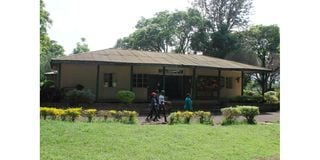Tracing how our ancestors lived in Nakuru Hyrax Hill

Hyrax Hill Prehistoric Site and Museum in Nakuru County. It is one of the sites where residents and tourists visit in large numbers to enjoy Kenya's heritage. Photo | John Njoroge
What you need to know:
By the 13th century, the Sirikwa people (spread all the way up to western and central Kenya) practised cereal cultivation and pastoralism. A museum with artefacts collected on-site and galleries exists on location
We’re on Hyrax Hill, meandering along the same earth from more than 5,000 years ago when our Stone Age ancestors were stepping into the Neolithic Age and later into the Iron Age. It was an exciting time for the new-age human. Our ancestors were now making more complex stone tools like sharp-edged obsidian cleavers, arrowheads, blades, and other sharp objects to hunt and slice open animals. They also were settling down in permanent villages; farming and keeping livestock and even engaging in pottery and weaving, evidence they left behind on the hill.
Named after the tiny animal, hyrax which is a relative of the gigantic elephant, descended from a common hooved ancestor that died out some 50 million years ago, based on their toes, teeth and skull.
The hills rise some 160 feet above the surrounding plains of Nakuru city with the prehistoric relics ‘discovered’ a century ago by Mrs Selfie – a funny name in today’s Information Age where anyone with a smartphone can take ‘selfies’ of themselves.
A dairy farmer, she lived on the volcanic hill with panoramic views from the high cliffs of the famous alkaline lake that fills with flamboyant flamingos when there’s plenty of algae to feast on and the 200,000 year-old Menengai Crater, with the last blast 8,000 years ago to form Africa’s second largest caldera carpeted in black lava that is being exploited for geothermal energy in the Great Rift Valley.
The dairy farmer contacted the Leakeys - Drs Louis and Mary - the famous duo of fossil research in East Africa. Mary began excavating the site in 1937 followed by others over the decades, giving us a glimpse of life once upon a time.
The farmer’s house built in 1905, has now morphed into a museum with artefacts collected on-site and galleries dedicated to present-day Kenya.
An artist’s impression paints a picture of the famous Sirikwa holes, the circular depressions excavated by Mary Leakey in the late 1930s, the first evidence of a settled community in East Africa.
The Sirikwa Holes
By the 13th century, the Sirikwa people practised cereal cultivation and pastoralism. The Sirikwa people on Hyrax Hill lived in settlements with a central depression for their cattle while they lived in huts connected to the cattle boma. They made things out of metal like the iron and bronze rings we see in the museum and pottery that’s unique to them. The Sirikwas spread all the way up to western and central Kenya. Today, there is the modern-day Sirikwa Hotel in Eldoret.
The trail from the museum leads to the Sirikwa holes, the Neolithic burial site and the ubiquitous bao game etched out on several rock surfaces. The game is among the oldest known board games in the world dating to the third century with literature revealing that even the ancient Egyptians played it. It spread across Africa, the Far East and the Caribbean. It’s a game of skill.
It’s a leisurely stroll along the path that has witnessed the evolution of humankind. A gentle wind ruffles the grass and suddenly Harriet Matsaert, our tree guide points to several trees in blooms of yellow flowers. “It’s the Carrot trees (Steganotaenia araliacea) flowering. They are spectacular.” These indigenous trees are fairly rare and are so-called because they have a distinct carrot smell and are highly medicinal. I wonder if our Neolithic family used them to treat any ailments.
www.rupitheafricantrotter.com
To Do in Nakuru
Spend an hour at Hyrax Hill (150kms west of Nairobi) discovering the world of our ancient ancestors. You can visit the Hindu temple next to it observing protocol when in a place of worship.
Menengai Crater is a 20-minute drive from it. The beautiful Maili Saba Camp sits on the rim from where you can hike down to the crater; drive to the sacred caves and visit the highest point which shows the mileages to cities in the world.
Visit Lake Nakuru National Park famous for its rhinos, lions, the occasional leopard, flamingos and a few hundred other species of birds.
Or combine Hyrax Hill with Kariandusi Prehistoric Site near Lake Elmenteita where Home erectus was busy making the Acheulean handaxes out of stone between 100,000 and 1.6 million years ago.




